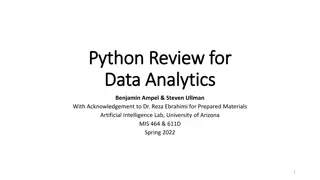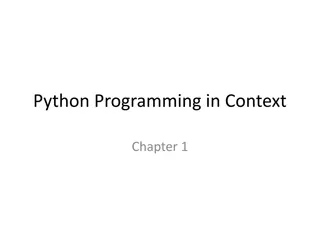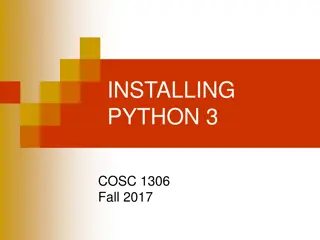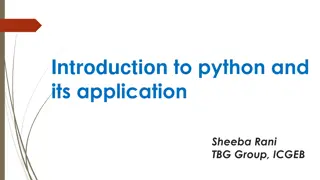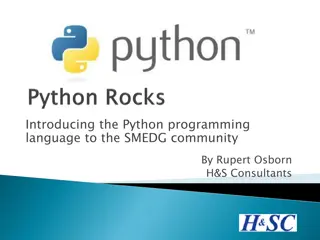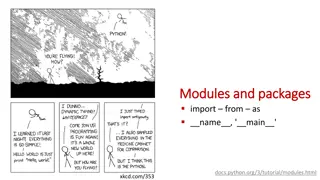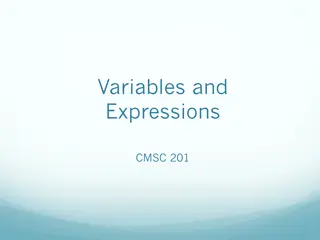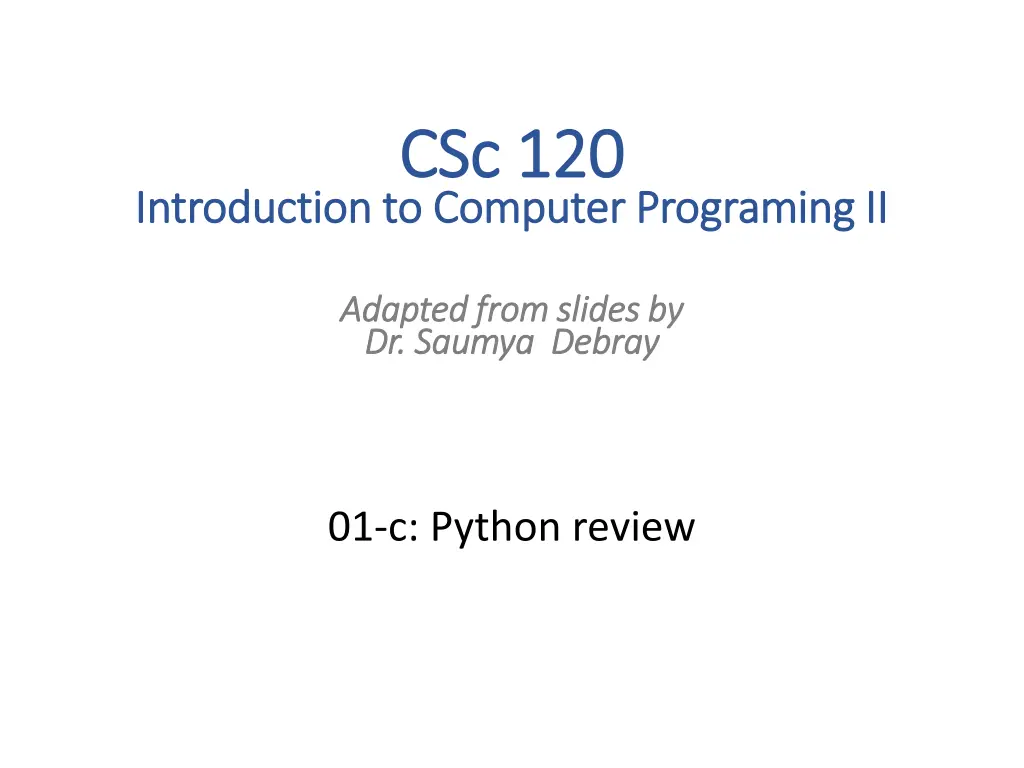
Understanding Python String Manipulation
Learn about Python string manipulation techniques such as splitting, joining, and trimming. Explore how to work with lists and strings to manipulate data effectively in Python programming.
Uploaded on | 6 Views
Download Presentation

Please find below an Image/Link to download the presentation.
The content on the website is provided AS IS for your information and personal use only. It may not be sold, licensed, or shared on other websites without obtaining consent from the author. If you encounter any issues during the download, it is possible that the publisher has removed the file from their server.
You are allowed to download the files provided on this website for personal or commercial use, subject to the condition that they are used lawfully. All files are the property of their respective owners.
The content on the website is provided AS IS for your information and personal use only. It may not be sold, licensed, or shared on other websites without obtaining consent from the author.
E N D
Presentation Transcript
CSc CSc 120 120 Introduction to Computer Programing II Introduction to Computer Programing II Adapted Adapted from slides by from slides by Dr. Dr. Saumya Saumya Debray Debray 01-c: Python review
python review: lists strings 3
Strings lists >>> names = "John, Paul, Megan, Bill, Mary" >>> names 'John, Paul, Megan, Bill, Mary' split() : splits a string on whitespace returns a list of strings >>> >>> names.split() ['John,', 'Paul,', 'Megan,', 'Bill,', 'Mary'] >>> >>> names.split('n') ['Joh', ', Paul, Mega', ', Bill, Mary'] >>> >>> names.split(',') ['John', ' Paul', ' Megan', ' Bill', ' Mary'] >>> 4
Strings lists >>> names = "John, Paul, Megan, Bill, Mary" >>> names 'John, Paul, Megan, Bill, Mary' >>> >>> names.split() ['John,', 'Paul,', 'Megan,', 'Bill,', 'Mary'] >>> >>> names.split('n') ['Joh', ', Paul, Mega', ', Bill, Mary'] >>> >>> names.split(',') ['John', ' Paul', ' Megan', ' Bill', ' Mary'] >>> split() : splits a string on whitespace returns a list of strings split(delim) : delim, splits the string on delim 5
Lists strings >>> x = ['one', 'two', 'three', 'four'] >>> >>> "-".join(x) 'one-two-three-four' delim.join(list) : joins the strings in list using the string delim as the delimiter >>> >>> "!.!".join(x) 'one!.!two!.!three!.!four' returns a string >>> 6
String trimming >>> x = ' abcd >>> >>> x.strip() 'abcd' >>> >>> y = "Hey!!!" >>> >>> y.strip("!") 'Hey' >>> >>> z = "*%^^stuff stuff stuff^%%%**" >>> >>> z.strip("*^%") 'stuff stuff stuff' ' x.strip() : removes whitespace from either end of the string x returns a string 7
String trimming >>> x = ' abcd >>> >>> x.strip() 'abcd' >>> >>> y = "Hey!!!" >>> >>> y.strip("!") 'Hey' >>> >>> z = "*%^^stuff stuff stuff^%%%**" >>> >>> z.strip("*^%") 'stuff stuff stuff' ' x.strip() : removes whitespace from either end of the string x returns a string x.strip(string) : given an optional argument string, removes any character in string from either end of x 8
String trimming x.strip() : removes whitespace from either end of the string x x.strip(string) : given an optional argument string, removes any character in string from either end of x rstrip(), lstrip() : similar to strip() but trims from one end of the string 9
EXERCISE EXERCISE >>> text = "Bear Down, Arizona. Bear Down, Red and Blue." >>> words = text.split() >>> words ['Bear', 'Down,', 'Arizona.', 'Bear', 'Down,', 'Red', 'and', 'Blue.'] >>> words_lst = [] >>> for w in words: words_lst.append(w.strip(".,")) >>> words_lst ['Bear', 'Down', 'Arizona', 'Bear', 'Down', 'Red', 'and', 'Blue'] >>> create a list of words with no punctuation 10
python review: reading user input II: file I/O 11
Reading user input II: file I/O suppose we want to read (and process) a file "this_file.txt" 12
Reading user input II: file I/O >>> infile = open("this_file.txt") >>> >>> for line in infile: print(line) line 1 line 1 line 1 open() the file read and process the file line 2 line 2 line 3 line 3 >>> 13
Reading user input II: file I/O >>> infile = open("this_file.txt") >>> >>> for line in infile: print(line) fileobj = open(filename) filename: a string fileobj: a file object line 1 line 1 line 1 line 2 line 2 line 3 line 3 >>> 14
Reading user input II: file I/O >>> infile = open("this_file.txt") >>> >>> for line in infile: print(line) fileobj = open(filename) filename: a string fileobj: a file object forvarinfileobj: reads the file a line at a time assigns the line (a string) to var line 1 line 1 line 1 line 2 line 2 line 3 line 3 >>> 15
Reading user input II: file I/O >>> infile = open("this_file.txt") >>> >>> for line in infile: print(line) fileobj = open(filename) filename: a string fileobj: a file object forvarinfileobj: reads the file a line at a time assigns the line (a string) to var line 1 line 1 line 1 Note that each line read ends in a newline ('\n') character line 2 line 2 line 3 line 3 >>> 16
Reading user input II: file I/O >>> infile = open("this_file.txt") >>> >>> for line in infile: print(line) line 1 line 1 line 1 At this point we've reached the end of the file and there is nothing left to read line 2 line 2 line 3 line 3 >>> 17
Reading user input II: file I/O >>> infile = open("this_file.txt") >>> >>> for line in infile: print(line) line 1 line 1 line 1 at this point we've reached the end of the file so there's nothing left to read line 2 line 2 to re-read the file, we have to close it and then re-open it line 3 line 3 >>> >>> infile.close() >>>infile = open("this_file.txt") 18
Reading user input II: file I/O >>> infile = open("this_file.txt") >>> >>> for line in infile: print(line.strip()) NOTE: we can use strip() to get rid of the newline character at the end of each line line 1 line 1 line 1 line 2 line 2 line 3 line 3 >>> 19
Writing output to a file >>> out_file = open("names.txt", "w") >>> open(filename, "w"): opens filename in write mode, i.e., for output >>> name = input("Enter a name: ") Enter a name: Tom >>> >>> out_file.write(name + '\n') 4 >>> name = input("Enter a name: ") Enter a name: Megan >>> out_file.write(name + '\n') 6 >>> out_file.close() >>> 20
Writing output to a file >>> out_file = open("names.txt", "w") >>> open(filename, "w"): opens filename in write mode, i.e., for output >>> name = input("Enter a name: ") Enter a name: Tom >>> fileobj.write(string): writes string to fileobj >>> out_file.write(name + '\n') 4 >>> name = input("Enter a name: ") Enter a name: Megan >>> out_file.write(name + '\n') 6 >>> out_file.close() >>> 21
Writing output to a file >>> in_file = open("names.txt", "r") open the file in read mode ("r") to see what was written >>> for line in in_file: print(line) Tom Megan 22
python review: tuples 23
Tuples >>> >>> x = (111, 222, 333, 444, 555) >>> x (111, 222, 333, 444, 555) >>> x[0] 111 >>> x[2] 333 >>> x[-1] 555 >>> x[-2] 444 >>> a tuple is a sequence of values (like lists) 24
Tuples >>> >>> x = (111, 222, 333, 444, 555) >>> x (111, 222, 333, 444, 555) >>> x[0] 111 >>> x[2] 333 >>> x[-1] 555 >>> x[-2] 444 >>> a tuple is a sequence of values (like lists) tuples use parens () by contrast, lists use square brackets [] parens can be omitted if no confusion is possible special cases for tuples: empty tuple: () single-element tuple: must have comma after the element: (111,) 25
Tuples >>> >>> x = (111, 222, 333, 444, 555) >>> x (111, 222, 333, 444, 555) >>> x[0] 111 >>> x[2] 333 >>> x[-1] 555 >>> x[-2] 444 >>> a tuple is a sequence of values (like lists) tuples use parens () by contrast, lists use square brackets [] parens can be omitted if no confusion is possible special cases for tuples: empty tuple: () single-element tuple: must have comma after the element: (111,) indexing in tuples works similarly to strings and lists 26
Tuples >>> x = (111, 222, 333, 444, 555) >>> len(x) 5 >>> x[2:] (333, 444, 555) >>> >>> x[:4] (111, 222, 333, 444) >>> x[1:4] (222, 333, 444) >>> >>> computing a length of a tuple: similar to strings and lists 27
Tuples >>> x = (111, 222, 333, 444, 555) >>> len(x) 5 >>> x[2:] (333, 444, 555) >>> >>> x[:4] (111, 222, 333, 444) >>> x[1:4] (222, 333, 444) >>> >>> computing a length of a tuple: similar to strings and lists computing slices of a tuple: similar to strings and lists 28
Tuples >>> x = (111, 222, 333, 444, 555) >>> x (111, 222, 333, 444, 555) >>> >>> y = (666, 777, 888) >>> >>> x + y (111, 222, 333, 444, 555, 666, 777, 888) >>> >>> y * 3 (666, 777, 888, 666, 777, 888, 666, 777, 888) >>> + and * work similarly on tuples as for lists and strings 29
Tuples >>> x = (111, 222, 333, 444, 555) >>> for item in x: print(item) 111 222 333 444 555 >>> >>> 222 in x True >>> 999 in x False >>> iterating through the elements of a tuple: similar to lists and strings 30
Tuples >>> x = (111, 222, 333, 444, 555) >>> for item in x: print(item) 111 222 333 444 555 >>> >>> 222 in x True >>> 999 in x False >>> iterating through the elements of a tuple: similar to lists and strings checking membership in a tuple: similar to lists and strings 31
Tuples >>> x = (111, 222, 333, 444, 555) >>> x (111, 222, 333, 444, 555) >> x[2] 333 >>> >>> x[2] = 999 Traceback (most recent call last): File "<pyshell#102>", line 1, in <module> x[2] = 999 TypeError: 'tuple' object does not support item assignment >>> tuples are not mutable 32
Sequence types: mutability tuples are immutable >>> x = ( ['aa', 'bb'], ['cc', 'dd'], ['ee'] ) >>> x[0] = 'ff' Traceback (most recent call last): File "<pyshell#108>", line 1, in <module> x[0] = 'ff' TypeError: 'tuple' object does not support item assignment 33
Sequence types: mutability >>> x = ( ['aa', 'bb'], ['cc', 'dd'], ['ee'] ) tuples are immutable >>> x[0] = 'ff' Traceback (most recent call last): File "<pyshell#108>", line 1, in <module> x[0] = 'ff' TypeError: 'tuple' object does not support item assignment >>> x[0][0] = 'ff' lists are mutable >>> x (['ff', 'bb'], ['cc', 'dd'], ['ee']) 34
Sequence types: mutability >>> x = ( ['aa', 'bb'], ['cc', 'dd'], ['ee'] ) >>> x[0] = 'ff' Traceback (most recent call last): File "<pyshell#108>", line 1, in <module> x[0] = 'ff' TypeError: 'tuple' object does not support item assignment >>> x[0][0] = 'ff' >>> x (['ff', 'bb'], ['cc', 'dd'], ['ee']) >>> x[0][0][0] = 'a' Traceback (most recent call last): File "<pyshell#112>", line 1, in <module> x[0][0][0] = 'a' TypeError: 'str' object does not support item assignment >>> tuples are immutable lists are mutable strings are immutable 35
Sequence types: mutability 0 1 2 tuple (immutable) x ( ) list (mutable) [ ] [ ] [ ] a a a string (immutable) e e e c c c d d d b b b 36
Sequence types: mutability 0 1 2 tuple (immutable) x ( ) list (mutable) updates [ ] [ ] [ ] a a a string (immutable) e e e c c c f f f d d d b b b 37
EXERCISE EXERCISE >>> x = [ (1, 2, 3), (4, 5, 6), (7, 8, 9) ] >>> x[0][0] = (2, 3, 4) what do you think will be printed out? >>> x[0] = [ 2, 3, 4 ] what do you think will be printed out? 38
Why use tuples? At the implementation level, tuples are much simpler than lists: lists are mutable; tuples are immutable this means that the implementation can process tuples without having to worry about the possibility of updates lists have methods (e.g., append); tuples do not have methods Tuples can be implemented more efficiently than lists 39
Summary: sequence types Sequence types include: strings, lists, and tuples The elements are: i, i+k, i+2k, ... Source: https://docs.python.org/3/library/stdtypes.html#sequence-types-list-tuple-range 40
python review: dictionaries 41
Dictionaries A dictionary is like an array, but it can be indexed using strings (or numbers, or tuples, or any immutable type) the values used as indexes for a particular dictionary are called its keys think of a dictionary as an unordered collection of key : value pairs empty dictionary: {} It is an error to index into a dictionary using a non- existent key 42
Dictionaries empty dictionary >>> crs_units = {} >>> crs_units['csc 110'] = 4 >>> crs_units['csc 120'] = 4 >>> crs_units['csc 352'] = 3 >>> course = 'csc 110' >>> >>> crs_units[course] 4 >>> crs_units {'csc 110': 4, 'csc 120': 4, 'csc 352': 3} >>> 43
Dictionaries >>> crs_units = {} >>> crs_units['csc 110'] = 4 >>> crs_units['csc 120'] = 4 >>> crs_units['csc 352'] = 3 >>> course = 'csc 110' >>> >>> crs_units[course] 4 >>> crs_units {'csc 110': 4, 'csc 120': 4, 'csc 352': 3} >>> empty dictionary populating the dictionary in this example, one item at a time 44
Dictionaries >>> crs_units = {} >>> crs_units['csc 110'] = 4 >>> crs_units['csc 120'] = 4 >>> crs_units['csc 352'] = 3 >>> course = 'csc 110' >>> >>> crs_units[course] 4 >>> crs_units {'csc 110': 4, 'csc 120': 4, 'csc 352': 3} >>> empty dictionary populating the dictionary in this example, one item at a time looking using keys (indexing) 45
Dictionaries >>> crs_units = {} >>> crs_units['csc 110'] = 4 >>> crs_units['csc 120'] = 4 >>> crs_units['csc 352'] = 3 >>> course = 'csc 110' >>> >>> crs_units[course] 4 >>> crs_units {'csc 110': 4, 'csc 120': 4, 'csc 352': 3} >>> empty dictionary populating the dictionary in this example, one item at a time looking using keys (indexing) we can populate it using this syntax 46
Dictionaries empty dictionary populating the dictionary in this example, one item at a time looking up the dictionary (indexing) looking at the dictionary we can use this syntax to populate the dictionary too indexing with a key not in the dictionary is an error ( KeyError ) 47
Dictionaries initializing the dictionary in this example, several items at once 48
Dictionaries initializing the dictionary in this example, several items at once getting a list of keys in the dictionary useful since it s an error to index into a dictionary with a key that is not in it 49
Dictionaries We can use a for loop to iterate through a dictionary 50










